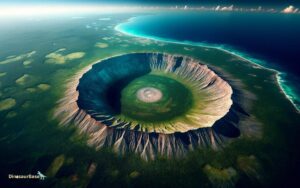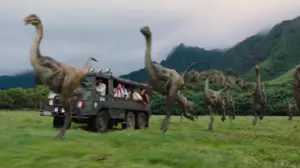Can Dinosaurs See in the Dark
Have you ever wondered if dinosaurs could navigate the murky shadows of their prehistoric world after sunset?
The question of dinosaur night vision offers a fascinating glimpse into the daily, or rather nightly, lives of these ancient creatures.
By comparing the anatomical structure of dinosaur fossils to the eyes of modern animals known for their nocturnal capabilities, scientists are beginning to piece together a story that might not only reveal the creatures' ability to see in the dark but also shed light on their hunting and social behaviors.
This exploration could significantly alter our understanding of dinosaur ecology, indicating a complexity we're only starting to unravel.
Key Takeaways
- Dinosaur fossils with large eye sockets and scleral rings suggest adaptations for low-light vision.
- Comparative anatomy indicates some dinosaurs may have had night vision similar to modern nocturnal reptiles.
- Predatory dinosaurs evolved sharp night vision for hunting, while herbivores developed it for predator detection.
- Fossil evidence, including track patterns and dental wear, supports nocturnal activities in some dinosaur species.
The Science of Dinosaur Vision
Understanding the science of dinosaur vision requires delving into the anatomical and physiological characteristics of their eyes. This provides insights into how these ancient creatures may have perceived their world. Researchers hypothesize that like their modern avian relatives, dinosaurs might've had complex vision systems. This complexity suggests they could discern a wide range of colors, aiding in mating, foraging, and predator evasion.
The presence of large optic lobes in certain dinosaur skulls implies advanced visual acuity. Moreover, the adaptation of their vision likely varied significantly across species, with some possibly possessing the ability to see in low light conditions, akin to nocturnal animals today. Such capabilities would've been crucial for survival, influencing their hunting strategies, habitat preferences, and social behaviors.
Anatomical Clues From Fossils
Exploring anatomical clues from fossils provides critical insights into the vision capabilities of dinosaurs, including their potential to see in the dark. By examining the fossilized remains of dinosaur skulls, researchers can infer the size, shape, and orientation of the eye sockets and the optic nerve canal. These features offer valuable evidence about the visual acuity of these ancient creatures.
- Orbital Size: Larger eye sockets may indicate adaptations for low-light environments.
- Scleral Rings: The presence and structure of these rings suggest eye shape and function.
- Optic Nerve Canal: Its size hints at the processing capability for visual information.
- Skull Shape: Indicates the field of view and potential binocular vision.
- Placement of Eyes: Side vs. front placement impacts depth perception and environment interaction.
This analysis sheds light on how dinosaurs might've navigated their ecosystems, potentially revealing nocturnal behaviors.
Comparing Dinosaur Eyes to Modern Animals
Drawing parallels between the ocular anatomy of dinosaurs and that of modern animals sheds light on the evolutionary adaptations for vision across millennia. Scientists have meticulously analyzed the fossilized remains of dinosaurs, focusing on the structure of their eye sockets and any preserved eye tissue, comparing these findings with the eyes of contemporary reptiles, birds, and mammals.
This comparison reveals how certain eye features, such as the size of the orbit, can hint at an animal's visual capabilities, including their potential for nocturnal activity. For instance, larger eye sockets may indicate adaptations for low-light environments, a trait seen in many modern nocturnal creatures. Additionally, the presence of scleral rings in some dinosaur fossils, similar to those in birds, suggests adaptations for acute vision.
This comparative approach not only enriches our understanding of dinosaur biology but also underscores the continuity of evolutionary trends in ocular development.
Night Vision in Today's Reptiles
Exploring the realm of night vision in contemporary reptiles reveals significant insights into their eye adaptations, which facilitate survival and predation under low-light conditions. These adaptations, including increased rod density and reflective layers, enhance their ability to navigate and hunt during nighttime, mirroring ancestral traits that may have been present in dinosaurs.
A comparative analysis of vision capabilities across different species provides a comprehensive understanding of evolutionary progress in nocturnal behaviors and sensory adaptations.
Reptilian Eye Adaptations
Many modern reptiles boast eye adaptations that enable them to navigate the darkness with remarkable efficiency, shedding light on potential nocturnal capabilities in their dinosaur ancestors. These adaptations include:
- Large pupils: They expand in low light, allowing more light to enter the eye.
- Tapetum lucidum: A reflective layer behind the retina, enhancing night vision by reflecting light back through the retina.
- High rod density: Rods are more sensitive to light than cones and are abundant in reptiles adapted to dim conditions.
- Low cone density: Cones are responsible for color vision, which is less crucial in the dark, leading to their reduced presence in nocturnal species.
- Vertical slit pupils: Found in some predators, they can control light intake precisely, optimizing vision in various light conditions.
These features underpin the impressive night vision capabilities observed in many of today's reptiles.
Predatory Nocturnal Behaviors
Building on the anatomical adaptations that enhance nocturnal vision in reptiles, this section examines how these features translate into effective predatory behaviors under the cover of darkness.
Many reptiles possess large corneas and pupils that expand significantly at night, increasing their ability to capture available light. This adaptation is crucial for hunting prey or evading predators in low-light conditions.
Additionally, a layer behind the retina, known as the tapetum lucidum, reflects light back through the retina, enhancing vision in darkness. This allows reptiles to detect movement and shapes with remarkable efficiency when nocturnal hunting.
The ability to process visual information rapidly is vital, as it enables these predators to make quick decisions, ensuring their survival and success in capturing prey at night.
Comparative Vision Capabilities
To assess the evolutionary progression of night vision, current reptiles provide a valuable comparison, showcasing a range of adaptations that enhance their ability to navigate and hunt in low-light environments. These adaptations are key in understanding how ancient dinosaurs might've operated during nocturnal hours.
- Tapetum Lucidum: A layer behind the retina reflects light, increasing the light available to photoreceptors.
- Large Pupil Size: Expands in low light to allow more light entry.
- High Rod Density: Rod cells, sensitive to low light, are abundant in the retinas of nocturnal reptiles.
- Reduction of Cone Cells: Fewer cone cells, which are used for color vision in daylight, optimize the retina for night vision.
- Adaptive Behaviors: Behavioral adaptations, such as being more active during twilight hours, complement physical eye adaptations.
These adaptations illustrate the complexity and variability of vision in reptiles, offering insights into possible nocturnal capabilities of dinosaurs.
The Role of the Dinosaur's Habitat
The dinosaur's habitat played a crucial role in shaping their ability to see in low light conditions. Varying light levels influenced evolutionary adaptations. Dinosaurs inhabiting dense forests or areas with prolonged periods of darkness likely developed enhanced nocturnal vision to navigate and hunt.
This adaptation underscores the link between environmental challenges and the evolution of sensory capabilities in ancient species.
Habitat Light Levels
Understanding the varying levels of light within a dinosaur's habitat is crucial for comprehending how these ancient creatures may have adapted their vision for survival. The habitat's light levels, influenced by geographical location, vegetation density, and temporal changes, played a significant role in shaping the visual capabilities of dinosaurs.
- Geographical location: dictated the amount of sunlight available.
- Vegetation density: determined the light's penetration through forests and jungles.
- Temporal changes: influenced by seasonal variations and time of day.
- Atmospheric conditions: such as cloud cover and dust, affected light intensity.
- Topographical features: like mountains and valleys, altered the distribution of light.
This analysis reveals the complexity of habitats and their direct impact on the evolutionary adaptations of dinosaur vision, underscoring the interconnectedness of environmental factors and biological traits.
Nocturnal Activities Adaptation
Exploring how dinosaurs adapted to nocturnal activities sheds light on the critical role their habitats played in the evolution of their night vision capabilities. Dense forests and dimly lit underbrush necessitated keen sensory adaptations for survival and hunting during nighttime.
The complexity of these environments led to the development of specialized ocular features, such as larger eyes and a higher concentration of rod cells, allowing for enhanced low-light vision. This adaptation wasn't uniform; it varied significantly across species, influenced by the ecological niche each dinosaur occupied.
Predators in shadowy habitats evolved sharp night vision as a hunting advantage, while herbivores developed it primarily for predator detection. Thus, the interplay between habitat and survival strategies sculpted the nocturnal capabilities of dinosaurs, illustrating a profound example of evolutionary response to environmental demands.
Behavioral Evidence of Nocturnal Activity
Several studies have suggested that certain dinosaur species exhibited behaviors indicating they were active during the night, pointing towards a possible adaptation for nocturnal activity. This claim is backed by a detailed analysis of their living habits and physical attributes that support a nocturnal lifestyle.
- Fossilized Track Patterns: Paths suggesting activities like hunting and foraging during nighttime hours.
- Dental Wear Analysis: Shows patterns consistent with night feeding habits.
- Bone Histology: Indicates growth patterns supportive of nocturnal vision adaptations.
- Nesting Sites: Positioned in ways that suggest avoidance of daytime predators or overheating.
- Predator-Prey Relationships: Certain dinosaurs' physical traits imply a shift in active hours to exploit less competitive nocturnal niches.
This evidence collectively hints at a complex behavioral adaptation among various dinosaur species to thrive in the dark, revealing a dynamic and adaptable approach to survival millions of years ago.
Advances in Paleontological Research
Advances in paleontological research have significantly enhanced our understanding of how dinosaurs adapted to nocturnal activities, employing innovative techniques and technologies to uncover new evidence. Scientists now utilize high-resolution imaging and 3D modeling to analyze fossilized eye structures, revealing adaptations indicative of night vision.
Comparative anatomy studies have also played a crucial role, comparing dinosaur eye fossils with those of modern nocturnal and diurnal animals to discern visual capabilities. Furthermore, the development of sophisticated computer simulations has allowed researchers to reconstruct ancient ecosystems, providing insights into the environmental conditions that dinosaurs navigated at night.
These methodological breakthroughs have offered unprecedented glimpses into the lives of these ancient creatures, shedding light on their behavioral adaptations to darkness.
Implications for Understanding Dinosaur Behavior
By uncovering adaptations indicative of night vision in dinosaurs, researchers have gained critical insights into their nocturnal behaviors, potentially revolutionizing our understanding of their daily life and survival strategies.
- *Adaptations for night vision suggest some dinosaurs were active hunters or foragers at night, avoiding the heat of the day.*
- *Nocturnal activities could imply complex social behaviors, such as night-time nesting or migration patterns.*
- *Understanding these behaviors helps paleontologists reconstruct ancient ecosystems, where nocturnal and diurnal species coexisted.*
- *The discovery of night vision capabilities could lead to a reevaluation of the predator-prey dynamics of the Mesozoic era.*
- *This knowledge enriches our comprehension of dinosaur sensory abilities, illustrating a more nuanced picture of their evolutionary adaptations.*
Conclusion
Despite skepticism about our ability to infer sensory abilities from ancient remains, current research provides compelling evidence that some dinosaurs likely possessed the capability to see in the dark.
By analyzing anatomical structures comparable to modern nocturnal animals and considering behavioral patterns suggested by fossilized evidence, scientists have begun to piece together a picture of dinosaur life after dark.
This insight not only enriches our understanding of dinosaur behavior but also highlights the complex evolution of sensory adaptations across millennia.




